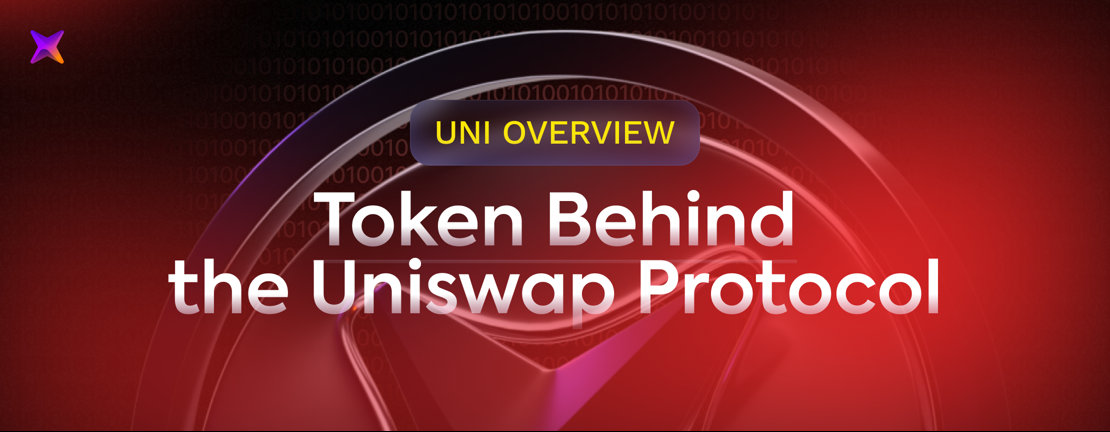Published 08 Jul 2025
Uniswap’s UNI Token: How Community Governance Shapes DeFi’s Future

Why UNI Token Stands Out Beyond Being a DeFi Asset
Uniswap didn’t just transform token trading — it handed over the reins of power. As one of the first decentralized exchanges to succeed, it showed that a financial platform could operate without one central group in charge. Things changed even more in 2020 with the release of the UNI token. This move passed control of the protocol to its own users marking a significant step forward.
UNI isn’t just about fee discounts or acting as a utility token. It works as a governance token, and this role is crucial. It allows users instead of founders or venture capitalists, to make decisions about how the protocol develops. Whether it’s launching new versions or handling the community treasury, UNI holders direct Uniswap’s path forward.
This article explains what UNI tokens represent, their role in Uniswap’s ecosystem, and how they became significant governance tokens in DeFi. They don’t just stand for decentralization. They’re the tool that drives it.
How UNI Began and What It’s Meant To Do
The UNI token came into existence driven by both necessity and creativity. By 2020 Uniswap ranked among Ethereum's top-used protocols operating without a token. Things shifted when competing platforms introduced their own tokens to pull in Uniswap’s users and liquidity. Uniswap reacted by creating UNI. This wasn’t a countermeasure — it signaled a move aimed at achieving complete community ownership.
Uniswap introduced UNI with a clear goal: to make Uniswap a public good that its users own and manage. To achieve this, the team dropped 150 million UNI to early users as a retroactive airdrop. This move transformed thousands of traders and liquidity providers into partial owners of the protocol almost. It became one of the most notable airdrops in the history of cryptocurrency and signified what UNI stood to represent.
UNI wasn’t just meant to reward users. The token was created to empower the community to decide on real matters like upgrading the protocol or funding projects. This marked the beginning of Uniswap shifting from being led by developers to becoming a decentralized ecosystem shaped by token holders.
How UNI Drives Decision-Making Through Governance
Uniswap runs its governance system on the blockchain, and its true strength comes from this setup. Every UNI token equals one vote letting token holders shape Uniswap’s direction. In many projects, governance feels like a formality, but that’s not the case here. Proposals, voting, and results all get tracked and enacted through smart contracts.
To submit a proposal, a person must have at least 2.5 million UNI, either owned or delegated. These proposals can cover a variety of topics such as technical changes, fee adjustments launching new initiatives, or bringing Uniswap to different blockchains. Once submitted, the community gets time to discuss and vote. If the proposal meets the required support, it enters a queue before being executed offering a clear and open process.
Delegation plays a key role in this system. Token holders can pass their voting power to groups or individuals who take an active role in governance. This setup helps smaller holders make a difference by backing delegates they believe in. The system aims to scale well. Not everyone needs to vote, but everyone has a chance to influence decisions.
Governance has shaped critical moves over time. It has approved decisions like creating the Uniswap Foundation, moving to chains such as Arbitrum and BNB, and funding projects to grow the ecosystem. These aren't just symbolic powers. UNI holders guide the future of one of the largest protocols in crypto.
UNI's Core Roles in the Protocol Ecosystem
UNI isn’t meant to trade, swap, or cover fees, and that’s by design. Its worth lies in the power it gives, not in how it’s used. UNI’s main role is to let the Uniswap community take charge of its tools and assets.
The main use of UNI is governance voting. People who hold the token get to make choices about things like protocol updates or spending from the community treasury. For instance, if there’s a plan to bring Uniswap to a new blockchain or change fee rules, UNI holders must vote to approve it through a formal process.
A key role is treasury management. The community treasury holds a large chunk of UNI tokens, and governance decides how to use those funds. This setup lets the community allocate money to give grants, boost liquidity, or grow the ecosystem without needing permission from a central authority.
Another feature is the fee switch. Uniswap's code has a tool that allows governance to direct part of trading fees away from liquidity providers and into the treasury or to UNI token holders. By default, this is turned off, but a vote could activate it. This gives UNI a possible way to earn based on protocol activity, though turning it on is still a topic of discussion.
UNI allows people to assign voting power and join off-chain discussions. Token holders can give their votes to delegates involved in governance efforts. This setup encourages passive users to become active contributors and stakeholders even if they do not submit proposals or write code.
UNI Token Distribution and How It Works
Uniswap designed UNI’s distribution to showcase its main idea: the protocol should be owned by its users. To make this happen, the launch featured one of the biggest and widest-reaching airdrops in the history of crypto. They gave free UNI to over 250,000 Ethereum addresses that used Uniswap before September 1, 2020. Each address received a minimum of 400 tokens instantly transforming regular traders into people who help govern the platform.
The airdrop was just one piece of the overall strategy. Developers set the total token supply at 1 billion UNI, with plans to release it within four years. They allocated 60% to the community, which included the airdrop and funds held in the treasury. The remaining 40% was assigned to team members, advisors, and investors combined with a multi-year vesting plan to maintain a long-term focus.
This design aimed to achieve two main things: broad ownership by the community and steady development. The DAO, controlled by UNI holders, uses the treasury funds to grow without needing outside investment. Meanwhile, the vesting plan stops sudden sell-offs and ensures key contributors stay focused on advancing the protocol.
Uniswap added a steady yearly inflation rate of 2% after the first four years of its release plan. This wasn’t meant to decrease value but to keep people motivated to govern and grow the platform. The idea is to create a lasting way to keep the ecosystem engaged, not just profitable.
To put it, UNI's distribution wasn’t focused on fairness. It aimed to create a strong system where power and duties are shared among everyone.
UNI’s Role in Upholding DeFi’s Core Principles
Uniswap goes beyond being just a trading tool. It stands as proof that financial systems can operate without gatekeepers. UNI plays a key part in bringing this vision to life, not within Uniswap itself but throughout the broader DeFi space.
UNI gives decision-making power to its token holders, which reflects the idea of decentralization. There’s no single executive taking charge, no private boardroom making secret choices. Major decisions, whether it’s launching updated versions or handling funds, rely on the community’s approval. This kind of openness and honesty makes DeFi different from traditional banks and institutions, and UNI turns those ideals into reality.
Uniswap's launch of UNI set what many see as the benchmark for DeFi governance. It wasn't about how large the airdrop was but what it stood for. It proved protocols could reward their early users, share power , and still work on a large scale. This move encouraged several other projects to roll out governance tokens taking notes from Uniswap's approach.
The UNI token does more than make users customers. It gives them a share in shaping the protocol's future. This shared interest between developers, users, and investors defines what sets DeFi apart. It's not about cutting out middlemen. It's about creating systems controlled by the people who use them.
Using governance, treasury management, and decisions shaped by its community, UNI has played a big part in making Uniswap one of crypto’s most decentralized and durable platforms. UNI is more than just a token. It acts as the system that keeps Uniswap aligned with the principles on which DeFi was founded.
UNI in Action and Its Place in the Crypto World
Although UNI supports governance, its role stretches far beyond Uniswap’s voting system. UNI has become a key part of the larger crypto network. It appears in several areas, including lending services and crypto index funds making it one of the best-known tokens in DeFi.
To begin, DeFi lending platforms like Aave and Compound recognize UNI as collateral. People can use UNI as a deposit to borrow stablecoins or other assets. This makes UNI a functional part of many DeFi portfolios. This shows confidence in UNI’s liquidity and trust in Uniswap’s future role.
UNI is also part of key DeFi index products, including the DeFi Pulse Index (DPI). These indexes let investors gain access to top governance tokens, with UNI almost always securing a top spot. This demonstrates UNI’s market value and its critical role in advancing DeFi.
Outside of finance, UNI promotes a rising system of delegate-driven governance. Tools like Tally and Sybil let people pick delegates to make decisions for them. Some delegates handle millions of votes and join in debates, protocol talks, and reviewing proposals. This setup pushes users to engage even if they don’t stay on top of every single vote themselves.
The initial airdrop also left a big mark. UNI set an example of how fair token distribution could work. It didn’t just reward users; it also turned many of them into committed token holders who stayed to help guide the protocol’s direction. Other DeFi projects still look back at this as a model for launching systems run by their communities.
UNI’s real-world uses and integrations prove it is more than just a token for governance. It contributes to DeFi’s financial systems, encourages participation, and aims to create fairer methods.
What’s Next: Uniswap v4 and the Future of UNI
Uniswap is planning its next big upgrade called Uniswap v4, and UNI is expected to play a bigger role. This new version will use a flexible design known as "hooks", to let developers change how pools work. It will also include upgrades like a single contract to cut down on gas costs while boosting efficiency. However, these changes depend on approval from the community, and UNI holders get to make those decisions.
Releasing v4 won’t come from a top-down call. Like earlier updates, it needs proposals, debates, and voting through governance. UNI holders will shape the protocol’s direction, decide when to introduce features, and guide how the ecosystem moves forward. Governance will also play a role in adjusting settings enabling new applications, or assigning funds to help developers work on v4.
Version 4 introduces new ways to generate income, adds more fee options, and connects more with other DeFi tools. It also shifts attention back to the fee switch, which lets UNI holders decide if some trading fees should go to the treasury or token holders. As Uniswap continues to grow and collect revenue, the community might rethink how value moves within the platform and what role UNI plays in it.
Uniswap keeps moving forward and shows no signs of slowing down. It stands out as one of the most reliable protocols in DeFi, yet it keeps striving to improve. The UNI token plays a key role in everything from governance to funding, upgrades, and overall strategy. With v4 on the way, UNI is set to influence not Uniswap's path but also the next chapter of decentralized finance as a whole.
Conclusion
UNI is more than just another token sitting in someone’s wallet. It works as a key part of Uniswap, helping shape it into a protocol guided by its community. Since the day it launched, it has changed how people view governance within decentralized finance. UNI holders have made big decisions, from massive airdrops and protocol updates to funding projects and spreading to other chains.
This token was built with a clear goal in mind: shared ownership long-term growth, and open involvement. It is not about jumping on hype or chasing quick gains. Instead, it gives users a real stake in the tools they use and a real say in how those tools evolve.
As Uniswap v4 approaches and the ecosystem keeps growing, UNI’s importance will grow even more. The token offers more than just access. It provides a way to have influence. In a decentralized system, that is what makes it valuable over time.
Read More




 Get RateX Pro
Get RateX Pro

 06 Jun 2024
06 Jun 2024
